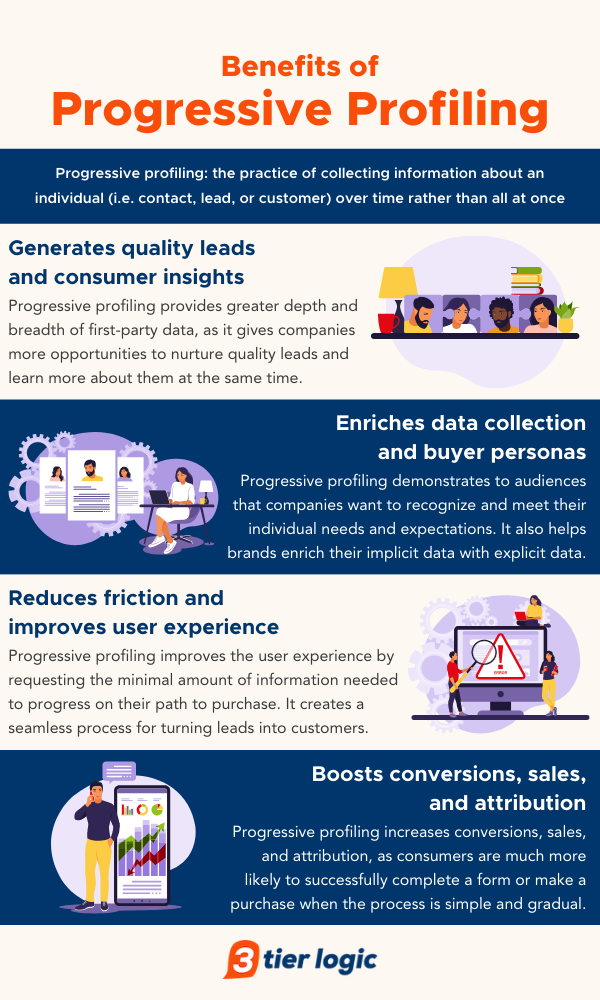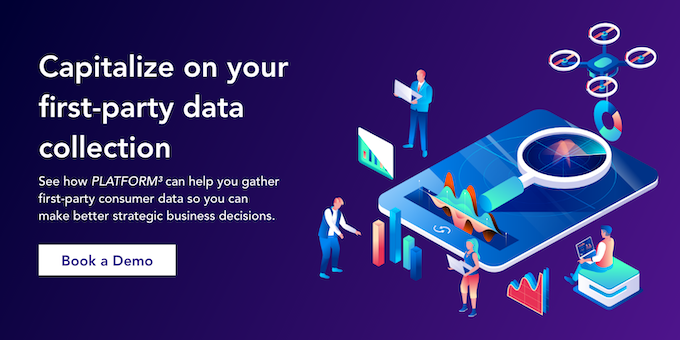How Progressive Profiling Boosts Lead Generation and First-Party Data Collection
When it comes to collecting consumer data, marketers often find it a difficult task to navigate. People tend to be cautious when providing their personal information, especially with ongoing consumer privacy concerns and data protection policies in place. However, to build effective buyer profiles and marketing campaigns, brands need to capture first-party data. Businesses should practice progressive profiling to strengthen their relationships with their customers while gaining the user insights they’re looking for. What is progressive profiling, and how does it work?
What is progressive profiling?
Progressive profiling is the practice of collecting information about an individual over time rather than all at once. This individual could be a contact, a lead, or an existing customer. The majority of progressive profiling is done through first-party cookies, which tracks user behavior on a brand’s own website. First-party cookies capture information about which pages they view, which links they click, which purchases they make, and so on. This compilation of first-party data helps to build each individual’s user profile, allowing brands to appropriately segment and target them based on their behavior, preferences, and expectations.
Progressive profiling can also be conducted through registration and lead capture forms. Businesses often use multiple forms to ask for small amounts of information each time as a way to avoid overwhelming their customers. For example, they might start by asking users for their name and email address when creating an account. Then, they can request users’ product interests and content preferences as they browse their website. Lastly, they’re likely to ask for their users’ phone number, shipping address, and payment information so they can complete their purchase.
Benefits of progressive profiling
Generates quality leads and consumer insights
When identifying potential customers, marketers want as much information as possible to determine the quality of the lead and the necessary steps for acquiring them. Progressive profiling gives businesses a greater depth and breadth of first-party data, as they can slowly nurture leads and learn more about them at the same time, rather than attempt to capture all of their information at once. In standard data collection practices, marketers may only be able to collect basic information about their leads like names, email addresses, and ongoing website activity. With progressive profiling, marketers have more opportunities to ask for more information, such as their product preferences and desired service features, before they even make a purchase.
Additionally, leads that provide deeper insights into their preferences and behaviors are more likely to take interest in forming a relationship with a brand, increasing their customer lifetime value. This also decreases a company’s customer acquisition costs, as progressive profiling helps them reduce the amount of money and resources put towards unqualified leads. Over time, this increases a brand’s revenue and return on investment as well.
Enriches data collection and buyer personas
Progressive profiling helps businesses create a more complete picture of their audience, as it enriches their implicit data (i.e. user behavior defined by email interactions, website activity, etc.) with explicit data (i.e. user information provided through forms, surveys, etc.). Once marketers collect consumers’ basic information, such as their name and email address, they can start asking more behavioral and preference-based questions, such as how often they shop or what product qualities they look for.
This data can then help segment their users into groups based on shared similarities and create personalized user journeys that foster customer retention, consumer loyalty, and even brand advocacy. It also improves both the quality and quantity of a brand’s zero-party and first-party data, resulting in a deeper understanding of their consumers. Progressive profiling demonstrates to audiences that companies want to recognize and meet their individual needs and expectations.
Reduces friction and improves user experience
For most people, the longer the registration form, the less likely they are to complete it. Forms that ask for unnecessary information or information that people don’t have committed to memory, such as their credit card number, can create a barrier to entry. Progressive profiling improves the user experience by requesting the minimal amount of information needed to progress on their path to purchase. Rather than filling out ten separate form fields, consumers only need to answer a few. Instead of providing their payment details at the start, shoppers only need to do so when completing a purchase.
Companies might also include a single sign-on (SSO) option to make the registration and log-in process faster and easier for consumers. In SSO, rather than starting from scratch, users create an account through other trusted websites, such as Google or Facebook. For the consumer, SSO reduces the number of steps they need to take and clarifies what information they need to share. For the company, SSO increases the number of sign-ups completed and helps them collect data from their audience’s other accounts. Progressive profiling creates a natural, seamless user experience and reduces the number of barriers between company and consumer, which helps turn potential leads into loyal customers.
Boosts conversions, sales, and attribution
As progressive profiling helps to reduce friction and user frustration, it also increases conversions and sales in return. Consumers are much more likely to successfully complete a form or make a purchase when the steps involved are completed over a gradual period of time, rather than all at once. As they provide more information, companies are able to better understand and serve their individual needs, leading to continuous conversions and purchases. Progressive profiling also helps marketers improve their attribution, as they can identify which steps of the data collection process contributed to a sale or other types of desired conversions, such as which website pages they viewed, which email links they opened, or which forms they completed.
Challenges of progressive profiling
Increases risk of oversaturation
If done incorrectly, progressive profiling can actually discourage customers from completing their user journey. Marketers need to be careful about how much information they ask for, when they ask for it, and most importantly, whether the information they’re asking for is necessary. For example, asking consumers to provide their shipping address long before they plan to make an online purchase can turn them away. Asking for users’ phone numbers when you have no intention of leveraging them may cause people to drop out of the sales funnel. Brands should prioritize quality over quantity to avoid overwhelming their audience and oversaturating their database with unnecessary information.
Creates complex user journeys
In a simplified data collection process, users may only have to fill out a few forms or answer a few sets of questions over the entire course of their relationship with a brand. For example, they might provide all of their contact information when they first interact with a business and all of their payment details when they make their initial purchase. In progressive profiling, marketers encourage consumers to take multiple smaller steps over an extended period of time, potentially making their user journey more difficult to navigate, especially if the steps aren’t made clear. Companies also have to wait longer to acquire the data they're looking for. To make it faster and easier for both parties, marketers should simplify the information gathering process as much as possible so that users know when, where, and how to move onto the next stage.
Progressive profiling best practices
Define customer segments and personas
Marketers should outline basic customer segments and buyer personas before they build sign-up forms or implement first-party cookies. That way, the information they collect helps to gain further insights into each predetermined group. For example, an alcoholic beverage company may want to differentiate between wine lovers and beer enthusiasts. A job search website should consider segmenting their users by career type, such as designers, programmers, and marketers.
From there, brands can slowly capture their data over time and send them targeted messaging and content relevant to their interests. They can also use this information to identify and target new segments of consumers as well. Progressive profiling may introduce them to audiences and leads they weren’t previously aware of.
Outline your audience’s path to purchase
Much of progressive profiling is understanding and refining a customer’s potential user journey from start to finish. Marketers need to define what steps they want people to take through the awareness, acquisition, purchase, loyalty, and advocacy phases, then determine what information they need to nurture them towards the next stage. For example, when encouraging leads to move from the awareness stage to the acquisition and purchase stages, businesses should collect data about what people look for in a brand, then showcase their best qualities in order to build trust and transparency.
Once they've determined what kinds of data they need, they can then decide how to capture it, such as through a survey landing page, in-store offer, or social media poll. Companies should consider all scenarios, perspectives, and consumer touchpoints to create the best possible user experience for everyone. This might mean refining their social content, improving their store displays, researching industry innovations, and so on. It may also mean implementing omnichannel marketing practices like push notifications and SMS marketing into their strategies to create smoother transitions between data collection procedures.
Prioritize clarity, usability, and relevancy
As mentioned previously, the main risks of progressive profiling are asking for more information than necessary, asking for information at the wrong time, and asking for information through complicated means. Marketers need to test each step of the data collection process by looking at how users engage with their brand.
For example, if they notice consumers mainly interacting with them on social media, they should consider sharing polls and surveys to collect first-party data about their purchasing behavior in a frictionless way. If they find that a significant number of people aren’t completing their account registrations, they should identify which form fields create disinterest or confusion. Rather than trying to gather as much information as possible in the shortest amount of time, marketers should look at progressive profiling as a way of putting the user’s experience first.
Leverage progressive profiling to capture first-party data
Data collection can be a complicated process, especially as governments, organizations, and individuals express their growing concerns over consumer privacy and data ownership. The best way to capture meaningful information is through progressive profiling, where companies gain user insights and first-party data over time. This allows consumers to maintain control over their information while strengthening their relationships with brands at the same time. In return, marketers obtain the data they need to generate quality leads, drive conversions and sales, and foster customer loyalty.
3 tier logic’s PLATFORM³ helps companies nurture brand engagement and capture valuable first-party data through sweepstakes, contests, loyalty programs, and more. The Data Capture & Analytics dashboard can give marketers a deeper understanding of their consumers’ behavior, leading to stronger data-driven business strategies. To learn more, book a demo with our team today.


